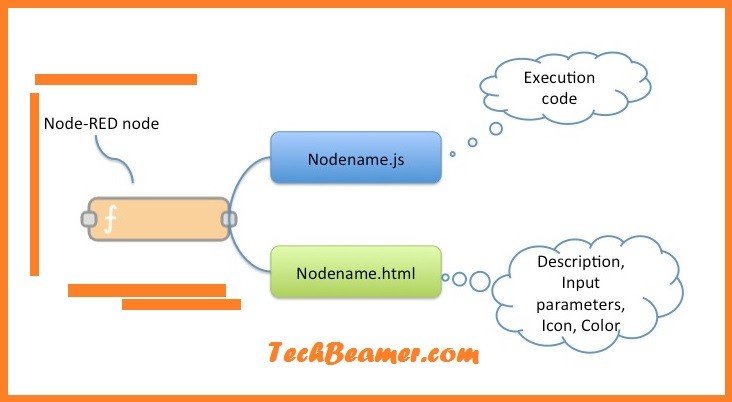Greetings readers, today we thought to share the Node-RED installation steps which can help you in setting it up in 10 minutes. This is one of the most trending tool for Internet of Things applications, and is being widely used to monitor the communication between the IoT devices. Software developers or the IT enthusiasts can easily download it and follow the Node-RED installation steps given here.
Just a little note on the background of Node-RED, it is a leading GUI application and platform independent interface engineered by IBM for linking the Internet of Things. Though IBM has already contributed it to the Open source community. Which is an open invitation to the developers of the world to add their own customization.
What is Node-RED?
Node-RED as its name reflects was developed using Node.js framework to bring out a light-weight and browser oriented user interface. It comes with a highly inter-operable design which allows it to link both physical and digital type of things together.

Node-RED Sample Workflow.
For using Node-RED one doesn’t need to be a seasoned programmer. Software engineers with less coding expertise can also contribute to the growth of this field. Most of the programming tasks in Node-RED are done visually, using pre-defined function nodes. You can perform drag and drop operation on these nodes and place them on a canvas to create the desired workflow. Any new functionality can also be added via JavaScript.
Node-RED doesn’t entirely replace the need of writing the code but significantly helps in reducing the development efforts. It enables the developers to focus on creating earth-shattering applications rather than duplicating efforts by writing same code over and over again.
Node-RED supports event based mechanism which makes it very easy to control the interconnection between multiple hardware. It is portable with all leading web browsers to allow easy formation of the functional work-flows related to Internet of Things. The light-weight nature of this application enables it to run on smaller devices like the BeagleBone and Raspberry Pi.
Let’s start the Node-RED installation.
Now I’ll demonstrate the steps to get started with Node-RED. I’ll be using the Ubuntu 14.04 server for Node-RED installation. There will be two main configuration steps to perform before you can see it running on your screens.

Installing Node.js
The very first item to install is Node.js. It is a JavaScript based ultra light-weight development platform which is getting popular day-by-day.
Node-RED works with Node.js version 0.10.x and 0.12.x. For our purpose, we’ll be downloading and installing the latest Node.js version. You now have to open up the terminal window, you can press CTRL+T to launch the terminal or select the terminal option from the desktop menu.
Note: Make sure you should login as a root user or you will use sudo if running as a standard user.
Removing the previous Node.js version.
You can skip these steps if you are installing Node.js for the first time. Else run the below commands to remove a previous Node.js installation.
| $ dpkg –get-selections | grep node techbeamers-node install node install |
If you find any previous “node” installed then run the following command to wipe it out entirely.
sudo apt-get remove --purge node
Perform the Node.js installation.
In the next set of instructions, we’ll run commands to install the latest version of Node.js. Lets start with the installation first.
sudo apt-get install nodejs
Now run the command to install the Node Package Manager known as “npm“.
sudo apt -get install npm
Create a symbolic link with name as “node” for “nodejs” which is a common term used by many Node.js tools.
sudo ln -s /usr/bin/nodejs /use/bin/node
Test the Node.js installation by executing the following commands:
| $ node -v v0.12.4 $ npm -v 1.4.28 |

Setting up Node-RED.
We have successfully configured Node.js, we can now jump on to downloading the Node-RED. The latest Node-RED version can be fetched from its GIT repository so that we can work on its most recent version updated with any new commits.
To download from GIT, you must make sure that you have GIT package installed. If it is not there, run the following command to get the GIT installed on your system.
sudo apt-get install git-core
After successfully installing GIT, navigate to your home directory to continue with Node-RED installation. I’ll now list out the steps that you will be executing to first clone the Node-RED repository and then install it using the “npm” command which is the Node Package Manager that we had earlier setup during Node.js installation.
| cd ~ git clone https://github.com/node-red/node-red.git cd node-red sudo npm install |
Starting Node-RED server.
Now we have come to the point where you are just a shot away from testing your first bit with Node-RED. Just double-check that you are still in the /home/node-red/ directory and set off the following command.
sudo node red.js
The above command will throw a lot of information on to the screen, which could be few errors about missing packages and all of the success messages. To verify that Node-RED is started, look out for the line containing the text similar to,
Node-RED available on the default 1880 port…
Now we are all set to open the Node-RED session into the browser. Open your default browser and type the following URL to see the Node-RED blazing.
http://localhost:1880
You will be presented with a blank work-space into the browser window with all the default functional “nodes” tiled on the left side of the screen. You can now play around with drag and drop feature to start linking things together.
Hopefully this article will help you in kick starting with Node-RED on Ubuntu. In the next article I’ll present you with a short init.d script to start/stop the Node-RED server and manage it as a service. Till then Bye! and Enjoy!
The post Getting Started with Node-RED installation appeared first on TechBeamers.